Studio rituals as therapy for art therapists
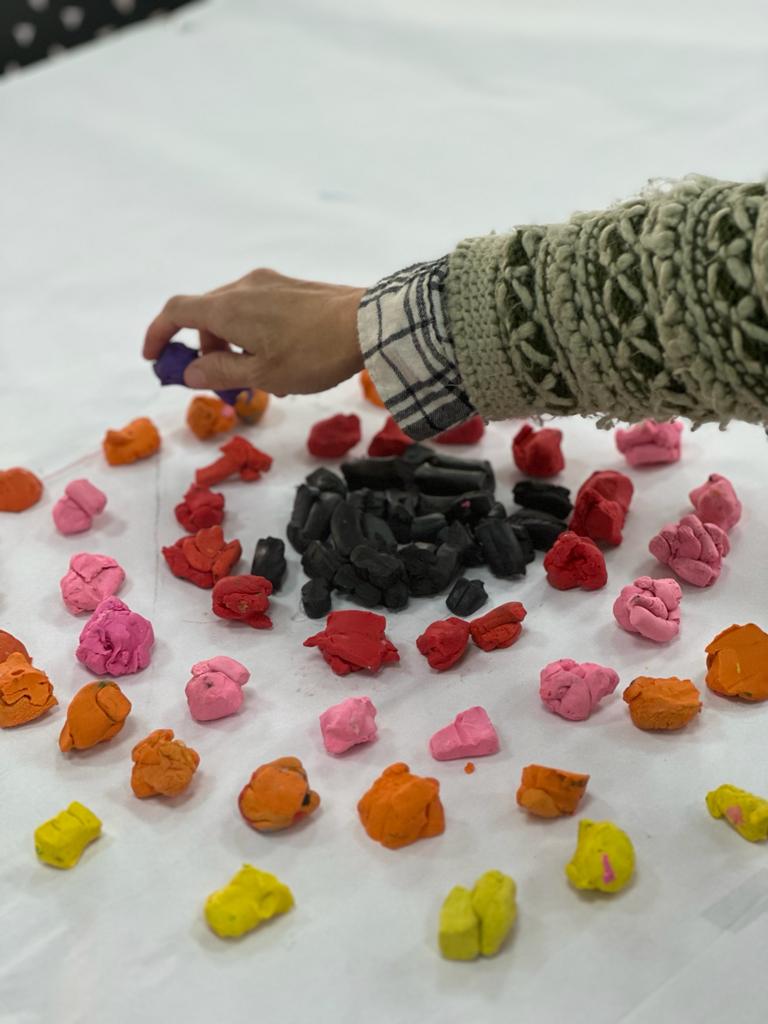
In response to the harrowing Pogrom events of October 7, 2023, the Creative Arts Therapies Association of Israel (YAHAT) swiftly established 40 safe studio spaces nationwide for evacuees. Spaces were assembled in hotels, community centers, camping sites, offices, and classrooms. As I write three months later, it seems that The Safe Studio has emerged as a vital sanctuary for all.
I wish to enhance and reframe the studio rituals as an aid that can support emotionally overwhelmed therapists.
Typically, therapeutic settings involve organized and sorted physical space for art making, a ceremony of entering and leaving the room, schedule, privacy, and the benevolent presence of a caregiver. These days, reality is reflected in studio processes, as we are all on an axis between chaos and regulation.
Safe Studios were set up within days! Families with children of all ages entered the space carrying heavy emotions, thoughts, and worries concerning the trauma of the events they had experienced. Volunteers arrive with bags of materials as a donation. Others were already choosing items from a material buffet that had begun to form and started to work. A team of art therapists is present in long shifts.
After a few chaotic days, the participants were divided according to age. And yet, they don’t necessarily meet the same persons. Nevertheless, it is still unclear how long the evacuees will stay in the hotel, when and how often the participants will meet, and with whom.
All the needs deeply challenge the caregivers’ attention. They face ambiguous therapeutic roles and blurred lines of therapeutic intent. The idea of therapy is not clear in this setting.
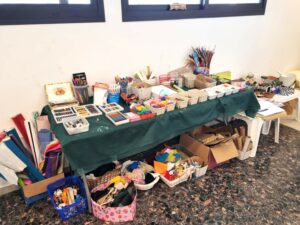
Yael Baraam Shalom termed it as “The evolution of the studio.” We can notice in this image she took on the first week how the presentation of materials and storage are mixed, and it is unclear what is what. There is no proper space, and inner and outer chaos are visual. Things stabilized slightly after about a week or two, but surprises and daily changes still exist.
But what did remain from a usual setting?
The beneficial presence and goodwill of the art therapists as a part of a team who conduct consultations and supervision.
A few therapists create alongside the participants as it supports them as well.
And they decide about the physical organization of space.
It is important to mention that despite all – the main feeling of the therapists within this hectic setting is that their work is extremely significant, especially because it is a nonverbal action-based process. Art as therapy, working in a studio – has become a central treatment in Israel. Many participants spent many hours every day working there.
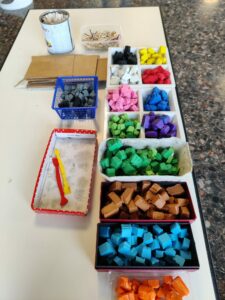

Yael Baram Shalom: after a week, we moved to a larger space and arranged each material on a different table. It brought much more calmness to the long days in The Safe Studio.
Gali Atiya, a studio in a kibbutz in the North.
Now, let’s reframe our perspective and view the studio as a therapist in itself, specifically for the therapists grappling with overwhelming circumstances.
The Role of Hands in Art Therapy
Art therapists recognize that bodily actions and busy hands express unspoken narratives and mental fluctuations. They represent an inner story that usually has no words or conceptualization.

Katie-Newburn
That’s why we strive to enable our patients to choose anything and create actions with materials and tools as they move around, explore, pick up objects or tools, connect, disassemble, and build. It can be a tiny pencil doodle, smearing plasticine on cardboard, delving through material drawers, placing a miniature on a table – just anything. The body and hands become channels for exploring, creating, and healing, offering a nonverbal outlet for emotions and thoughts.
The movements, actions, and choices produce mental connections between neurons and synapses; thus, another move is naturally invited. One thing leads to the other. It’s an endless activated living spiral of body and brain that works throughout our lives.
Eventually, our movements process meaning, especially if a witnessing therapist supports them.
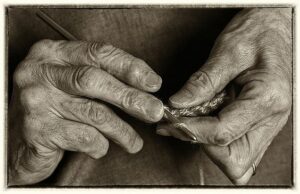
Geoff France
It means that the creator, using their own hands, explores, forms, and expresses his soul and heals it.
Our hands are the container and the tool that processes feelings, thoughts, and emotions – even before conceptualization!
Thus, the movement of the body symbolizes vitality and resilience.
Thus, I suggest to those who work these days in Safe Studios and are exposed to deep distress – to use their own hands as a tool to support their mental health.
How?
It is worthwhile to emphasize the rituals of organizing space and sorting materials as a physical-mental-conscious opportunity to create regulation, a quiet and beneficial metronome rhythm. If, until now, we looked at the studio mainly as a good enough container for our patients, we will now operate it as a container that takes care of us – the therapists.
What does this mean?
So far, you have organized the studio for your patients and your comfort.
I suggest you focus on exercising your hands and body more consciously.
The studio will be conducted through rituals of mindful choices regarding the organization, the attitude toward objects, and materials sorting.
Naama Avihud
If the emphasis was more technical before the war, I propose looking at it now from a meditative, symbolic, and spiritual essence.
These days, especially in the Safe Studios, it seems that if you intentionally treat the surroundings with personal rituals by your hands – you will strengthen your sense of control and anchor yourself when the other components of the setting are shaky.
Your tiny organizing activities in the safe studio are a ritual and an alchemical tool.
This mental capacity will help you maintain a center and stability. Think of it like an oxygen mask on an airplane where the mother puts it on her face first, and only then does she help the child.
As a team, hold in mind the intention and meditation of sorting materials with your hands as a method of self-regulation and control in the face of uncertainty.

Joan Melick
During the COVID-19 pandemic, many people found well-being and a sense of control by arranging a cabinet they hadn’t opened in years, sorting the library, or planting a garden. So here, too, such orders are a rest for the soul.
During your time in the safe studio, especially after difficult moments, periodically return to your inner core through simple organizing activities. Reflect on what brings comfort and what needs adjustment, and consider it a form of mental autonomy. Look around: what is comfortable? What’s less? Is it necessary to fill a container? Perhaps there is a need to hide one material and take out another? Are there scattered items that need to be bundled? Is there a need to sweep or change how the plasticine is suggested?
Such daily refinements will also become a conscious and regulated process for caregivers!
These seemingly technical activities are a small ceremony that expresses, preserves, and enhances your sense of mental autonomy.
A team of therapists in a Safe Studio, who mutually conduct sorting rituals – create with their hands a kind of spell and an alchemical act that gives control over this small reality.
It is a mental intention for the benefit of self-care. It’s part of a setting that can be developed and maintained and will safeguard you.
All these will provide a rhythm and anchor to all present, including the evacuees, in an overwhelming, unexpected, and painful reality. It will be reflected unconsciously – because the body understands.
Please share with me if you tryed it and how it went. we are all in a learning process.
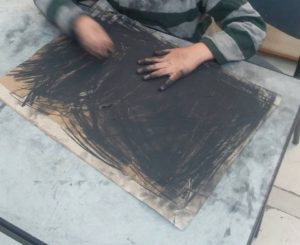
Very touched by your work. What a blessing to create a place of comfort during such a chaotic and challenging time.
Thank you Doreen!